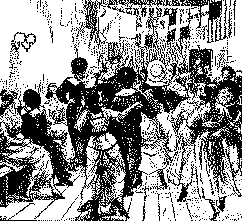
Dominic Vautier 1/22/11

The last dance was over,
the music had ceased,
And the dancers were leaving the hall,
A few men were saying their last good byes,
To the beautiful belle of the ball.[1]
Dancing is a natural reaction of the body to rhythmic stimulus. We are programmed to dance; we are dancing animals. From the mother’s first heart beats that an unborn baby experiences, to the thump, thump of footsteps, to the tap, tap of rainfall and the march of marching drums, rhythm is all around us. It is built into us from the first moment of our consciousness, and even before that I think. It is like breathing. Nature is rhythm. The human body is tuned to rhythm, and it needs rhythm to survive.
Dancing is an expression of this function. When a song begins playing there is a bookmark inside our brain that recalls the first stirrings of life, namely our first perceptions of consciousness that came from a rhythmic pumping of blood through the umbilical cord. All of us, whether we like it or not, are recipients of rhythm, and we are all born into a world that takes it for granted and expects it from us.
Primitive man made dancing the expression of every kind of emotion. Success in the hunt, birth of a child, marriage and funeral rites, initiation of a young man into the tribe, worship of gods and propitiation of evil spirits were all accompanied by dances. No primitive tribe has been discovered where dancing is not an important part of the culture[2]
When we dance, we direct our
rhythmic movement toward some objective. That objective can be anything; making it rain, celebrating a
harvest, succeeding in the hunt, having intercourse, or simply
celebrating the joy of being alive. If the dance is fast then often the goal is an external one,
such as hunting, or harvesting or having a good time, or just
releasing tension. If
the dance is slow it is internalized and involves more complicated
emotions, such as romance and love, in which case the dance is like
a mating ritual. Many of
the songs of the late 1800s and early 1900s were slow dances that
had strong romantic content; these were mating rituals.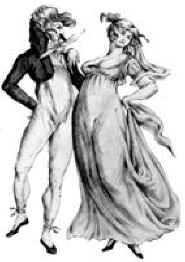
Some societies have considered dancing a very important part of life. Louis XVI, for example, realized the value of dancing and commanded that all of his court, especially the commissioned officers, learn how to dance, “thereby befitting themselves to be more proficient in the art of war”.[3] He apparently realized the significance of regular exercise as well as good mind-body coordination. Queen Elizabeth I appointed official teachers of dancing called dancing masters. Anyone who taught dancing without the Royal Warrant was liable to the death penalty.[4] The average Elizabethan was most likely merry in his dancing, but the upper classes evidently took the whole thing quite seriously.
By the 1900s social dancing had become an important male-female interaction in American society, and in fact this was often the only way that young people could properly meet. Their enthusiasm for this activity was not always understood by their parents. This is a theme recurring with each new wave of young people, and such resistance to change was illustrated most recently in the 1960’s, when the older generation had a difficult time trying to figure out how two people could just go out on the dance floor and endlessly gyrate and wiggle and flop around without following any particular dance discipline. That’s exactly the kind of experience that grown-ups were having with young people in the 1890’s. Here is one observation from 1894:
As far as I can see all you have to do is grab hold of the nearest lady, grasp her very tightly, push her shoulders down a bit, and then wiggle about as much like a slippery shush as you possibly can.[5]
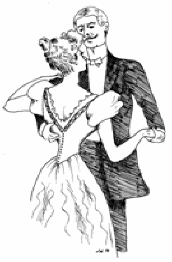
But young America has always wanted to dance. By 1898 there were at least three American dances in common use: the one-step, the two-step, and the three-step, or better known as the Slow American Waltz. Later on, around 1914, two more dances were beginning to appear, the Fox Trot and the Tango, imported from South America. Although the Fox Trot did not officially appear until 1914, evidence existed that dances with Fox Trot type steps were danced as early as 1896. At the time they were just looked upon as one more kind of “ragtime” dance. A few years later, after 1920, a whole collection of new dances appeared, such as the Rumba, the Samba, the Mambo, the Black Bottom, and the more notable Charleston.
So four types of dances were popular during the period from 1892 until 1915. The one-step, (and this includes ragtime dances), the two-step, the American Waltz, and also toward the end of this period, the Fox Trot. But first I want to talk about ragtime.
When someone says ragtime, it can generate confusion and even controversy because people have different ideas about exactly what it means. Ragtime can produce a whole set of different perceptions depending on musical backgrounds and tastes.
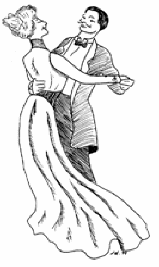
Here are some definitions of ragtime which are all perfectly valid:
1. The original classical American music form invented by Scott
Joplin.
2. The syncopated rhythm that first appeared on Broadway and
in popular music about 1896.
3. The fox trot-like dance step introduced by Barney Fegan
after 1896.
4. Any type of music having a
“ragged” rhythm i.e., syncopation. This syncopation was around with early cakewalks, which date
from 1860.
5. Anything that was new and novel and
different.
6. Any person associated with anything
new and novel and different.
7. A new, free-swinging, and
irreverent attitude toward life.[6]
We have ragtime gals, ragtime cowboys, Maple Leaf Rags, ragtime suffragettes. The list goes on. But it’s probably good to distinguish between Classic Ragtime and the many verities and forms of popular ragtime, which can take on any number of flavors.
Classic Ragtime is considerably different from popular ragtime, in fact it is different from just about all other types of music as well. Classic Ragtime music aficionados and purists are very insistent that such distinctions be made, and that Classic Ragtime be recognized as a unique musical entity. Classic Ragtime refers to the strictly classical style of music invented and introduced by Scott Joplin and others in the 1890’s. It enjoyed a short interval of popularity, mostly around St. Louis and New Orleans, even though it did not achieve the kind of universal acclaim that we like to think it did.
Another type of ragtime was being
developed on the east cost at about the same time. My Gal is a High Born Lady, for example, written by Barney Fagan,
hit Broadway and then the streets of
Some will continue to argue that Joplin was solely responsible for the introduction of syncopation into mainstream music. Evidence suggests that this was not the case. Syncopated, or “ragged”, music had certainly been around long before Scott Joplin’s contributions. By 1899, the year his Maple Leaf Rag achieved mainstream popularity, (the only one of his songs that did [7]), syncopation had become well established on Broadway and vaudeville. It was also becoming part of popular music too. Certainly popular songwriters borrowed some material from Classic Ragtime (they borrowed anything they could anyway), but syncopation was not new to them since it was already around. Nevertheless Classic Ragtime enthusiasts are to this day resentful of the way in which this music was exploited for profit.
There is irony to be found in the very fact of popular ragtime’s vast success. The commercial tunesmiths of Tin Pan Alley did their level best to ruin the music, to wring every last dollar from cheap and trumped-up imitations of a folk music and to glut the market to the last extreme. They succeeded only too well [8].
The Classic Ragtimeists can make a case, but what they object to is not unique to the ragtime era. Their objection really centers on the omnivorous nature of the popular music business itself, where everything is fair game in the pursuit of commercial success. It always has been this way and it will always will be. Certainly popular hits were around like Hello my Baby (1899), and Bill Bailey (1901), heavily syncopated, which came out soon after Maple Leaf Rag. It’s very likely that these songs were inspired by Scott Joplin’s work. After all, Joe Howard who wrote Hello, My Baby, already had a good deal of exposure to that kind of music, since he had lived and worked in St. Louis, the arbitrary home of Classic Ragtime.
The sad thing about Classic Ragtime is that it was too soon for its time, or maybe too late, or something like that. People didn’t really know what to do with it and treated it like novelty music. It was without question the first really original classic music to originate from this continent, and perhaps the first original American music of any kind.[9] But it was woefully ignored, and ended up fading away, although some Classic Ragtime characteristics were later absorbed into the Blues and Jazz.
The real story of ragtime is that of a song that came from the people and got lost. It is a story of a music that millions of Americans remember still, with some affection. It is a story that has never been told [10].
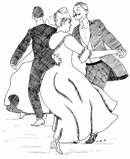 A
big reason for Classic Ragtime’s market failure, compared to
popular ragtime’s overwhelming commercial success, was that
Classic Ragtime had no words. Accordingly,
there was no story and the classical form made for difficult or
impossible dancing.
A
big reason for Classic Ragtime’s market failure, compared to
popular ragtime’s overwhelming commercial success, was that
Classic Ragtime had no words. Accordingly,
there was no story and the classical form made for difficult or
impossible dancing.
American popular ragtime music, on the other hand, had a strong story line and was very danceable. With Classic Ragtime, as with most classic music, people were expected to sit back and listen to the music, and enjoy it [11]. This did not go over well with the entertainment-thirsty crowds in the cities who had worked hard all week and wanted to kick up their heels on Saturday night. These people were the primary consumers of popular music and Popular ragtime was what they danced to. It was so easy to dance to, it was a lot of fun, and there was a lot of it available. Barney Fagan, Joe Howard, Harry Von Tilzer, Al Piantadosi, Irving Berlin and many others were ready and able to crank out tune lots of ragtime stuff to satisfy the dance-happy crowds.
But there is a way to take a Classic Ragtime piece apart and make it danceable. It has a tight structure consisting usually of three parts, each with its own melody, counterpoint, and syncopation. A good piano player can take a Joplin piece apart and split up the three melodies, select the most danceable, and embellish and rework that single melody to come up with some good dance music. These musicians may have even gone to Procrustean[12] lengths in their zeal to make this music suitable for dancing [13]. A good example is Easy Winners, which has a very danceable second melody. The transition to the third melody presents a problem because syncopation changes abruptly, something which would cause confusion on the dance floor, and would most likely be modified by a capable piano player. Others include Swipesy Cake Walk and Sunflower Slow Drag.
The argument may go on forever and it is mostly a question of musical taste. One thing is for sure, the music of Scott Joplin was unique and classical, and had very little to do with the common, everyday ragtime that became the mainstay of Tin Pan Alley during those years. All other music that has the slightest hint of syncopation, or has a “free-swinging, and irreverent attitude toward life” as Irving Berlin says, is just plain ordinary wonderful ragtime.
The Inuit people of northern Alaska cannot define ordinary snow. They instead have about 50 definitions for kinds of snow: soft snow, cold snow, dry snow, wet snow, heavy snow, but no one word for just plain snow. Well in this case the reverse is true. There is one word for something that has a million definitions, and that one word is ragtime.
 The two-step is simply a march.
Marches were very popular during the Civil War and for good
reason. Marching is an
efficient way to move large numbers of troops, and march tunes are a
good way to get this done. After
the war, its popularity continued unabated for the next thirty years
or so, championed by such greats as Pat Gilmore and John Philip
Sousa. Once marches had
become favorites with the public it was natural for the music to
appear in the dance hall. People
wanted to hear their favorite songs, not only in the park and the
parade ground, but in the ballroom as well. And those who stood to benefit from satisfying public
desires, like the providers of popular music in the dance halls,
were more than willing to promote dance steps that went with popular
marches. And so the
two-step evolved. It was
nothing more than just walking to the beat [14].
It could be spiced up with side steps or little bobs and
weaves. It could
introduce a little kick once in a while to stem off the sheer
monotony and boredom of just walking around the dance floor in time
to the music. It was an
easy dance to learn, and an easy dance to get tired of. Anyone who could walk, could two-step.
But the two-step was not capable enough of innovation, not
resilient enough to incorporate into its pattern the ragtime rhythms
that came along after 1898.
The two-step is simply a march.
Marches were very popular during the Civil War and for good
reason. Marching is an
efficient way to move large numbers of troops, and march tunes are a
good way to get this done. After
the war, its popularity continued unabated for the next thirty years
or so, championed by such greats as Pat Gilmore and John Philip
Sousa. Once marches had
become favorites with the public it was natural for the music to
appear in the dance hall. People
wanted to hear their favorite songs, not only in the park and the
parade ground, but in the ballroom as well. And those who stood to benefit from satisfying public
desires, like the providers of popular music in the dance halls,
were more than willing to promote dance steps that went with popular
marches. And so the
two-step evolved. It was
nothing more than just walking to the beat [14].
It could be spiced up with side steps or little bobs and
weaves. It could
introduce a little kick once in a while to stem off the sheer
monotony and boredom of just walking around the dance floor in time
to the music. It was an
easy dance to learn, and an easy dance to get tired of. Anyone who could walk, could two-step.
But the two-step was not capable enough of innovation, not
resilient enough to incorporate into its pattern the ragtime rhythms
that came along after 1898.
 By 1905 the two-step had
mercifully fallen out of popularity and was replaced by the
one-step, which had a higher level of complexity associated with it.
The one-step overwhelmingly replaced the two-step, although
people hardly noticed the difference or that the name of the dances
had changed. They
continued to call the new dance the two-step. All they remembered was that they liked the way dancing was
changing. By 1900 two
major types of dance steps had emerged, the one-step, which could
handle full time and also cut-time syncopation, as well as slow
dances, and the waltz, which handled three-quarter time music.
Marches stopped being played in ballrooms where they didn’t belong
anyway. Ballrooms were for dancing, not for military exercises, and
marches moved on to the realm of football fields and parades.
By 1905 the two-step had
mercifully fallen out of popularity and was replaced by the
one-step, which had a higher level of complexity associated with it.
The one-step overwhelmingly replaced the two-step, although
people hardly noticed the difference or that the name of the dances
had changed. They
continued to call the new dance the two-step. All they remembered was that they liked the way dancing was
changing. By 1900 two
major types of dance steps had emerged, the one-step, which could
handle full time and also cut-time syncopation, as well as slow
dances, and the waltz, which handled three-quarter time music.
Marches stopped being played in ballrooms where they didn’t belong
anyway. Ballrooms were for dancing, not for military exercises, and
marches moved on to the realm of football fields and parades.
The one-step was a collection of dances loosely termed “Ragtime Dances” or more correctly, popular ragtime dances, which emerged to handle the massive increase in young people looking for an easy dance that could be done to the slightly faster music tempos and the syncopation that was quickly coming into vogue.[15]
This dance applied to any kind of dance that used a constant tempo usually in cut time (half time or two beats per measure) with one step taken to each beat of the music.[16] The dance easily handled new forms of syncopation and allowed the dancers more freedom of expression. The one step could be done in the open position or the closed position with participants facing each other. All that was needed was to learn a simple throw-over[17] followed by a close-up and you instantly became the life of the party. The one-step was eventually able to assume a lot of variations such as the Turkey Trot, the Grizzly Bear, the Bunny Hug, The Boston Dip, The Shiver Dance, The Hug-Me Close to name just a few. The evolution of one-step music into a number of variations is quite similar to what happened in the 1960’s with The Twist, The Monkey, The Swim, The Locomotion, Mashed Potatoes, The Watusi, The Limbo and many other off-shoots of rock dancing.
A further advantage of the new dance was that it could be done at different tempos. Speeding the music up or slowing it down didn’t make it any more difficult to dance.
At the time a great many moralists objected to one-step dance done at a slower tempo, because it permitted what was vehemently denounced as “lingering close contact.”[18] It was simply the dance of choice for any piece in slow full-time or cut-time music; in other words, just about anything that was not a waltz could be a one-step. Up until ragtime dances were introduced, the only ballroom tempos were the waltz and the military march-time two-step, so the one-step was definitely a hot new kid on the block.
When this new dance step started to become popular, many dance instructors ignored it. They considered the one-step and it’s many variations to be vulgar, crude and plain unsophisticated. Instructors who did venture into teaching these dances were often resented by their more conservative peers. It wasn’t until after 1898 that instructors began to incorporate the one-step and its variations into repertoire. The increasing popularity of this dance step finally forced dance masters to accept it, but until then they refused to take it seriously. That, of course, is exactly what instructors had thought about slow waltzes 30 years earlier.
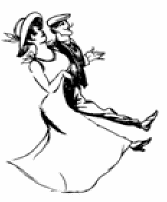 One
popular variation of one-step was the Cakewalk, which differed from
other one-steps because it was always open-coupled. This
means that the couple danced side-by-side instead of facing each
other, and the line of dance was directly forward instead of at an
angle like the usual one-step.
Early cakewalk is hard to recommend to anyone who is not an
athlete. It requires a
very flexible spine and a good sense of balance. It is a little reminiscent of Limbo
Rock dances of the 1950’s, where the person who dances lowest
under a pole wins. Just
as in the Limbo Rock,
Cakewalks require a dancer to lean backwards. The
difference is that you have to strut like royalty at the same time
that you are leaning back at an angle, and usually wind up flat on
your butt and in bed the next day.
One
popular variation of one-step was the Cakewalk, which differed from
other one-steps because it was always open-coupled. This
means that the couple danced side-by-side instead of facing each
other, and the line of dance was directly forward instead of at an
angle like the usual one-step.
Early cakewalk is hard to recommend to anyone who is not an
athlete. It requires a
very flexible spine and a good sense of balance. It is a little reminiscent of Limbo
Rock dances of the 1950’s, where the person who dances lowest
under a pole wins. Just
as in the Limbo Rock,
Cakewalks require a dancer to lean backwards. The
difference is that you have to strut like royalty at the same time
that you are leaning back at an angle, and usually wind up flat on
your butt and in bed the next day.
Cakewalks were first developed among American slaves as a high stepping promenade that ridiculed the proud and haughty ways of plantation owners. Because syncopation is an intrinsic part of cakewalk, and because it first appeared around 1860, we can probably conclude that some type of syncopation was being used in dance music at least as early as the Civil War. The dance allowed for improvised syncopated steps, dips, bobs, and chasses. It became extremely popular in Europe for a short time around 1885.
The one-step cakewalk could be danced to any of the syncopated pieces of the late 1890’s. Popular cakewalk pieces were Bill Bailey, Hello, My Baby, My Gal is a High Born Lady, and I’d Leave My Happy Home For You. The cakewalk got its name because the couple who did the best cakewalk won the cake.
Cakewalks also contributed some interesting terms to American metaphor. Doing anything difficult or outrageous certainly “takes the cake” because only by such exotic behavior could one hope to win a cakewalk contest. But by 1915 a cakewalk had become no more than a graceful promenade and the term instead began to mean something easy to do; people therefore said, “it’s a cakewalk”, or “It’s no cakewalk.”
No other dance was ever as popular during this period as the Slow American Waltz. Of the many songs which are listed in some of my collections and sold over a million copies were most always waltzes. Not only did waltzes predominate by sheer numbers, they were the absolute blockbusters. Really big early sellers such as After the Ball, Daisy Bell, Bird in a Gilded Cage and all the beer hall songs of Harry Von Tilzer and others totally blew away the competition. As late as 1909 waltzes were still without any question the biggest song type and continued to dominate ballroom dancing. Double whammy hits of that time, Meet me Tonight in Dreamland and the following year, Let Me Call You Sweetheart again blew the charts to pieces. They were waltzes. Together these two sold over 10 million copies in a short period. America was simply waltz-crazy.
Writers mistakenly characterize this period as the “Age of Ragtime” or the “Ragtime Era” or something more recognizable, because the waltz is not very exciting to those who never experienced it. However, the facts speak otherwise. If anything, the era should most appropriately be called the “Slow American Waltz” period because this was the dominant dance form of the time.
Slow American Waltzes did not lose favor with dance crowds until the outbreak of World War One. Ballrooms today occasionally feature a waltz, but almost nobody dances it anymore because the tempo is way too fast or if authentic at 30 measures a minute it seems far too slow.
The waltz was a European import. There are records as early as 1570 of a Bavarian dance similar to a waltz.[19] It was strenuously opposed for its lewdness, and has always had a controversial history as well as a questionable moral reputation. One example of this reaction can be found in the writings of Johann Von Munster when he visited the French court.
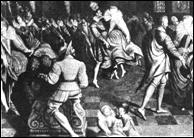 With
horror I have often seen this dance at the Royal Court of King Henry
III in the year 1582, and together with other honest persons have
frequently been amazed at such a lewd and unchaste dance…[20]
With
horror I have often seen this dance at the Royal Court of King Henry
III in the year 1582, and together with other honest persons have
frequently been amazed at such a lewd and unchaste dance…[20]
Even as late as 1668 the dance was still under sharp attack from moralists and intellectuals alike. In a passage from Johann Pretorius he describes the waltz as a “…whirling dance full of scandalous, beastly gestures and immodest movements …” [21].
But none the less waltzes started to become popular in fashionable ballrooms in the early the 1800's. That popularity soon spread to America where the waltz had to contend with many other dances of the time such as the Virginia Reel and the Quadrille. The mere fact that it was a closed-couple dance and involved body contact was a cause of considerable dismay [22].
When the waltz started being done in the United States, it changed. The innovative Americans slowed down the quick Viennese tempo, which required the stamina of Olympic athletes, to a more manageable 30 to 35 measures per minute, and renamed it the “American waltz.” [23]. American dance schools and the piano industry, which I already talked about, decided that there was definitely an opportunity to make money on this dance so they pushed the idea that the ability to dance was synonymous with social success.
Dancing lessons were given a big boost when Ward McAllister, a social lion of the late nineteenth century, made clear to socially ambitious mothers in New York the real power of dancing class, i.e., the power to propel their children up the social ladder.[24] Just as every parlor needed a piano and every young daughter likewise needed to play the piano, so too she needed to be able to dance in order to attain a respectable and suitably appropriate position in life.
The waltz symbolized romance, more than any other dance of this period. Other dances, Fox Trots, two-steps, one-steps, are fun to do, but the waltz represented absolute romance. The waltz was commitment.
By the early 1800's the waltz took a controversial step when the man was allowed to put his right hand around the lady’s waist [25]. This sparked a great debate over the decency of engaging in public hand-to-body contact and body-to body contact while dancing. On one side of the issue were those who felt that this much public touching would undermine social order; on the other side were those who loved to waltz. The enormous popularity of the Strauss family’s Viennese waltzes overcame such significant opposing social pressures and propelled the waltz into fashionability.
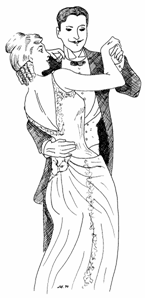 In
1892 a new version of the American waltz appeared. It originated in the north eastern part of this country and
was called the Boston.
This dance employed techniques, such as, hip to hip contact,
and a tighter closer hold, considered very scandalous [26].
All of this occurred within the context of the more lingering
slow tempo of Slow American Waltz (30 to 35 measures per minute).
In
1892 a new version of the American waltz appeared. It originated in the north eastern part of this country and
was called the Boston.
This dance employed techniques, such as, hip to hip contact,
and a tighter closer hold, considered very scandalous [26].
All of this occurred within the context of the more lingering
slow tempo of Slow American Waltz (30 to 35 measures per minute).
Early and strong opposition to The Boston came from all quarters. Actual demonstrations and protests occurred. It was just too much like a mating dance people said, too close to a ritual of lovemaking and sex. The mere fact that dancers hips were joined and in motion was suggestive of copulation itself, and this was absolutely intolerable to those raised under a Victorian ethic. The unspoken law during these times was that what goes on in the bedroom, stays in the bedroom, and what’s better, never comes out of the bedroom.
This is not at all without some parallel in the 1950's. Television crews were not allowed to show Elvis Presley below the waist, or they stood to lose many key sponsors who denounced Presley’s hip movements and other suggestive gyrations as lewd and openly sexual.
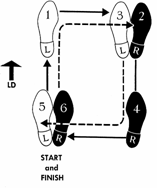 There
is a flowing lilt to the Slow American Waltz that is not present in
any other dance. The
footwork consists of a basic box step. The waltz is a progressive dance that requires smooth and
continuous movement along the line of dance. It is characterized by an erect posture, a rise-and-fall
motion, and communicating interaction achieved by both hip contact
and leg movement of both partners. There is about a quarter turn involved in each series of
steps. What is quite interesting
about the waltz is a constant movement of the partners legs between
each other which has been interpreted by some as erotic. Consider this quote from a typical dance instruction book:
“On count four, the man steps back onto the ball of his
right foot. The woman
steps forward on her left foot and slides it between the man’s
legs.” [27]. This is a powerful and exciting interaction.
There
is a flowing lilt to the Slow American Waltz that is not present in
any other dance. The
footwork consists of a basic box step. The waltz is a progressive dance that requires smooth and
continuous movement along the line of dance. It is characterized by an erect posture, a rise-and-fall
motion, and communicating interaction achieved by both hip contact
and leg movement of both partners. There is about a quarter turn involved in each series of
steps. What is quite interesting
about the waltz is a constant movement of the partners legs between
each other which has been interpreted by some as erotic. Consider this quote from a typical dance instruction book:
“On count four, the man steps back onto the ball of his
right foot. The woman
steps forward on her left foot and slides it between the man’s
legs.” [27]. This is a powerful and exciting interaction.
A most unique aspect of the waltz is that it involves a joining of bodies. It is very difficult to dance well without this contact because the female partner, who generally follows, must feel what her male partner is doing, and where he is going, and when he is going to reverse or change direction, or do a hesitation, or turn hard, or not turn at all. There is no way to dance a good waltz unless the partners move as one unit. The American waltz requires hip to hip contact. It is an essential part of the dance.
Slow American Waltzes were probably an excellent representation of a danced mating ritual that we have ever had in our society. Supported by an apparently inexhaustible supply of popular waltz music obliging produced by Tin Pan Alley from 1892 until as late as 1912, the waltz was the unquestioned queen of the industry.
After 1912 waltzes began to wane. This trend continued through the war years into the 1920’s, when it was completely replaced by much snappier and faster dances such as the Fox Trot, The Mambo, Rumba, Black Bottom and Charleston . The waltz eventually became confined to follies and revues. Tempos increased to athletic speeds thus changing the dance from a pleasurable and enjoyable form of recreation into an aerobic exercise. The disappearance of the Slow American Waltz from ballrooms was a real loss because it deprived us not only of a charming and pleasurable social experience, but also a true mating ritual. We have not seen its like since.
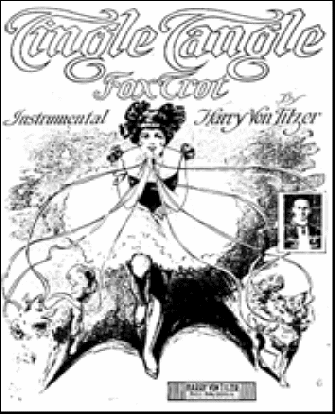 Fox Trot
Fox Trot
Fox Trot was the answer to a
growing need for a more sophisticated dance steps, one that could
support full-time tempos, and one that could also accommodate
syncopated songs. By
1914, the one-steps were no longer the novelty that they had once
been. Something new was
needed, so in the summer of 1914 the Fox Trot took the country by
storm. It was
popularized by one Harry Fox, a song-and-dance man from vaudeville.
The dance step that he used in one of his vaudeville acts was
a hit with his 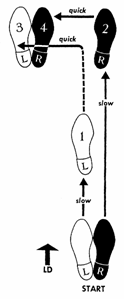 audience,
and almost instantly the dance became the rage of town as well as
the country.
audience,
and almost instantly the dance became the rage of town as well as
the country.
The Fox Trot was considered one of the most significant developments in all of ballroom dancing. Unlike Slow American waltzes, which were a variation of earlier European Viennese waltzes, the fox trot was a totally new form of dance, and also totally American. It almost certainly was around in one form or another before Harry Fox, but Harry gave it a clear definition and a name. The unique combination of two slow steps followed by two quick steps allowed much more flexibility and provided much greater dancing pleasure then monotonous one-steps [28]. Some Fox Trot lovers say that there is more variety in the fox trot than in any other dance, including the Tango and the Rumba. For that same reason they also claim that the Fox Trot is the hardest dance to completely master [29].
While it is true that Harry Fox popularized the dance, it is also true that Barney Fegan had 18 years earlier, developed a slow-slow-quick-quick ragtime one-step that closely resembled Fox Trot. Today nobody worries too much about it, since this dance step is no longer in common use. Let’s just say that if Harry Fox may had been in the right place at the right time, whoever his forerunners were, he was the one directly responsible for the Fox Trot fad.
As has been mentioned earlier, a rapid growth of the cities was given impetus from two major sources, first, from people moving from rural areas into the cities in search of work, and secondly, by an increase in first-generation immigrant Americans. This was especially true of New York, the premier docking point for newly-arrived immigrants. These people quickly took up jobs in the garment industry and the building trades. They worked as clerks, typists, secretaries, telephone switchboard operators, piano teachers, steel workers, tradesmen and laborers. They often became street vendors until they could make enough money to open their own shops. They found lodging in boardinghouses or wherever they could. They often worked long hours. The big difference between these new occupants of the city and those who belonged to the established order was that these newcomers had disposable income, even when young, and could spend their Saturday nights away from parental supervision. They tended to assimilate the trends of their peer groups, and left their cultural backgrounds behind. They became Americanized, seeking out whatever customary recreation was available in the big city.
For young men there were many options: ballrooms, saloons, brothels, tea gardens, vaudeville houses, and Broadway. For young women the choices were more restricted, usually just movie houses, ballrooms, amusement parks, and nickelodeons. Ballrooms emerged as chief among these options and became a primary source of evening recreation for the many young people who came to live and work in the big cities [30]. By 1908 ballrooms had become their primary place of social interaction.
Dance fever probably reached its peak by1913. New York City alone had close to seven hundred dance halls, studios, Jardins, and places where people could dance from noon until dawn the next day. Even in 1913 it was true that New York never sleeps because there were taxi-dances, dime-a-dance halls, tea dances, tango teas, and tea bars, which seldom served tea. Vendors at Coney Island even had to cut down the size of their concessions to make room for many large outdoor dance floors that were being built.[31]
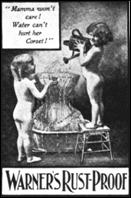 No one can really say how much
ballroom dancing influenced clothing styles and fashion; but fashions were definitely changing.
Is important to mention that there was a need for
looser-fitting clothes, both in the workplace and during
recreational activities, and certainly on the dance floor.
Bustles was gone by 1890, and the corset was being abandoned
by many young working women. Some
places of employment discouraged young women from wearing corsets
because the shops were hot and humid, and the employees had to sit
for long periods of time. Because
of these conditions and the physically restrictive nature of the
corset itself, women found it hard to breathe and often fainted thus
wasting work time. Switchboard operators could not wear
corsets because their legs lost circulation, necessitating their
getting up and walking around frequently. Employers saw the definite advantage of keeping their
employees comfortably dressed, so they tried to promote use of
looser fitting clothes and discouraged tight corsets. This trend toward use of more casual clothing in the
workplace then transferred over into recreational activities.
No one can really say how much
ballroom dancing influenced clothing styles and fashion; but fashions were definitely changing.
Is important to mention that there was a need for
looser-fitting clothes, both in the workplace and during
recreational activities, and certainly on the dance floor.
Bustles was gone by 1890, and the corset was being abandoned
by many young working women. Some
places of employment discouraged young women from wearing corsets
because the shops were hot and humid, and the employees had to sit
for long periods of time. Because
of these conditions and the physically restrictive nature of the
corset itself, women found it hard to breathe and often fainted thus
wasting work time. Switchboard operators could not wear
corsets because their legs lost circulation, necessitating their
getting up and walking around frequently. Employers saw the definite advantage of keeping their
employees comfortably dressed, so they tried to promote use of
looser fitting clothes and discouraged tight corsets. This trend toward use of more casual clothing in the
workplace then transferred over into recreational activities.
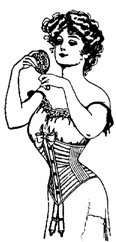 The
corset itself was radically changing.
Corsets of 1910 were in many ways quite different from what
women wore in 1890, consisting of a far more relaxed fit with a
longer and looser shape. Sales
of older style corsets began to drop after 1895, and in order to
keep up with women's modern activities, bicycle riding, boating,
dancing, and to appeal to the growing number of women in the labor
force, corset manufacturers designed newer corsets to be much more
flexible and comfortable. The
band of ribbing (stiff material that circled the waist) was reduced
in height from eight inches to about four inches so that women were
basically un-corseted around the rib-cage. They could actually breath, and also had much more
flexibility of movement.
The
corset itself was radically changing.
Corsets of 1910 were in many ways quite different from what
women wore in 1890, consisting of a far more relaxed fit with a
longer and looser shape. Sales
of older style corsets began to drop after 1895, and in order to
keep up with women's modern activities, bicycle riding, boating,
dancing, and to appeal to the growing number of women in the labor
force, corset manufacturers designed newer corsets to be much more
flexible and comfortable. The
band of ribbing (stiff material that circled the waist) was reduced
in height from eight inches to about four inches so that women were
basically un-corseted around the rib-cage. They could actually breath, and also had much more
flexibility of movement.
Another feature of newer corsets were garter straps. Women usually wore ankle-high light boots and knee-high stockings at work or around the house. When they went dancing they needed to wear a lighter dancing shoe, which required a thigh-length stocking, usually of cotton, though silk was quite fashionable for those who could afford it. The newer style corset had built-in garter straps which kept stockings from coming down, and which avoided the use of an garter belt. While dancing, women became very conscious of the need for good hosiery support because of the dips and flows of the waltz, as well as the high steps of ragtime music. This also required a slightly higher hem line that occasionally exposed the ankles. It was considered a terrible embarrassment for a woman to reveal sagging stockings or to expose any part of her bare leg. So garter straps and thigh-high cotton or silk stockings were considered essential in the active recreation of dancing.
Other things were also happening in women's dress. The French brassiere was by necessity coming into style, because the newer corset did not come up high enough under the breasts to provide bosom support. Lacy camisoles were a must for any girl going to a ballroom dance, because the light see-through bodice outer garment readily revealed what was underneath. A looser-fitting bodice also became popular and allowed free movement of the arms.[32]
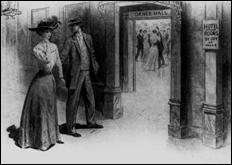 The older generation were by no means passive onlookers while these
cultural transformations were going on. They strongly objected.
Dance
halls were denounced as “pits of iniquity” and tools of the devil from many a pulpit.
Even dancing itself was denounced. In some parishes, young Catholic girls who went to confession
were admonished to confess that they had engaged in “the immoral
practice of dancing” before being allowed to receive communion.
In other parishes and congregations as well, the question was
seriously asked “If
young people go dancing on Saturday night, can they actually be
allowed to go to church on Sunday and receive sacraments before
going to confession?” In
1892, T. A. Faulkner published his famous book From
the Ballroom to Hell where
he stated that dancing was responsible for 81 percent of the “
fallen women” in
Los Angeles.[33]
Some time later, E.M. Whittmore, a noted social commentator,
proclaimed that 70 percent of “fallen girls” in New York had been ruined by Jazz.[34]
The older generation were by no means passive onlookers while these
cultural transformations were going on. They strongly objected.
Dance
halls were denounced as “pits of iniquity” and tools of the devil from many a pulpit.
Even dancing itself was denounced. In some parishes, young Catholic girls who went to confession
were admonished to confess that they had engaged in “the immoral
practice of dancing” before being allowed to receive communion.
In other parishes and congregations as well, the question was
seriously asked “If
young people go dancing on Saturday night, can they actually be
allowed to go to church on Sunday and receive sacraments before
going to confession?” In
1892, T. A. Faulkner published his famous book From
the Ballroom to Hell where
he stated that dancing was responsible for 81 percent of the “
fallen women” in
Los Angeles.[33]
Some time later, E.M. Whittmore, a noted social commentator,
proclaimed that 70 percent of “fallen girls” in New York had been ruined by Jazz.[34]
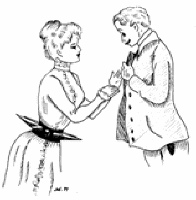 Some
attempts to curb these evils went beyond the ideological. Mechanical devices called “bumpers” were invented to
enforce a respectable distance between dance partners. The “Princess Lily Girdle” for example consisted of a
broad belt worn about a lady’s waist, containing a band of steel
and several pointed metal spikes to keep the male dancing partner at
a proper distance.[35]
Needless to say, the device did not catch on.
Some
attempts to curb these evils went beyond the ideological. Mechanical devices called “bumpers” were invented to
enforce a respectable distance between dance partners. The “Princess Lily Girdle” for example consisted of a
broad belt worn about a lady’s waist, containing a band of steel
and several pointed metal spikes to keep the male dancing partner at
a proper distance.[35]
Needless to say, the device did not catch on.
But the older generation did not give up its resistance. Edward Bok, editor of the Ladies’ Home Journal, fired fifteen of his office girls for dancing the Turkey Trot at lunch break.[36] Respectable members of society gathered to discuss the moral threat posed by many new dances.
A special meeting of six hundred society people, social workers, clergymen and city officials was held at Delmonico’s Restaurant in New York City where exhibitions were given of the turkey trot, and other dances. They shuddered at the shiver, gasped at the bunny hug, and denounced just about any cheek-to-cheek dancing.[37]
Regardless of dismay and disapproval from high places and low places as well, young people seemed determined, then as now, to make their own rules. There were a variety of new institutions springing up in many cities that encouraged a new social and sexual ethic among working class youth. This included not just ballrooms, but vast amusement parks, usually built at the end of streetcar lines, where the young people could lose themselves in the crowds, or wander off by themselves and engage in all frivolous and scandalous activity.[38] These parks consisted of many dark and isolated corners, as well as loud and boisterous entertainment areas, the very makeup of which encouraged a style of interaction that mocked more restrictive social customs of the older generation. These young working people were determined to dance to their own tune, both on and off the dance floor.
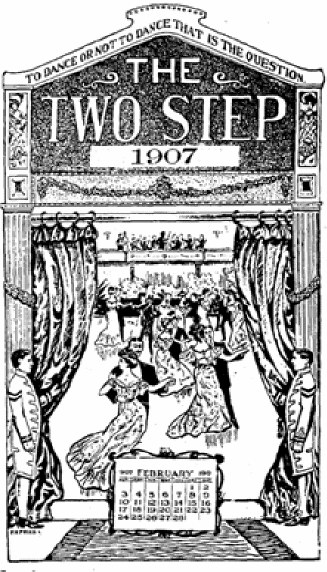 This was the atmosphere of the
times, the 1890's. Older
generations had difficulty accepting a new morality. Dress styles were changing, work habits were changing and
recreational patterns were evolving so fast that it was difficult to
follow it all. Ballrooms had
become hangouts and gathering places of young people. They lived a new kind of life.
They worked hard, they played hard, they danced the way they
wanted to. Most
importantly, they believed that they had a right to their own way of
fulfillment. These
headstrong young people insisted on dancing “obscene” American
waltzes and dancing it close up, hip to hip. Young men and women were doing cakewalks and ragtime dances
with wild abandon. Young
girls were going unescorted to dances with strange (un-introduced)
men. Younger people wanted
to dance all Saturday night and sleep all the next day, the Lord’s
day and missing religious services. They wanted to forget the old ways and be as American as…
as… as the music they danced, so they were dancing into the future
and leaving the older generation behind.
This was the atmosphere of the
times, the 1890's. Older
generations had difficulty accepting a new morality. Dress styles were changing, work habits were changing and
recreational patterns were evolving so fast that it was difficult to
follow it all. Ballrooms had
become hangouts and gathering places of young people. They lived a new kind of life.
They worked hard, they played hard, they danced the way they
wanted to. Most
importantly, they believed that they had a right to their own way of
fulfillment. These
headstrong young people insisted on dancing “obscene” American
waltzes and dancing it close up, hip to hip. Young men and women were doing cakewalks and ragtime dances
with wild abandon. Young
girls were going unescorted to dances with strange (un-introduced)
men. Younger people wanted
to dance all Saturday night and sleep all the next day, the Lord’s
day and missing religious services. They wanted to forget the old ways and be as American as…
as… as the music they danced, so they were dancing into the future
and leaving the older generation behind.
Here are some other links in this article:
Origins of Early Popular Music
Minstrelsy
Broadway
Vaudeville
Other
sources
People Growth - the First Baby Boom and it's effect
[1]
Arthur Lamb and Harry Von Tilzer,
The Mansion of Aching Hearts, 1903. The picture is from a copper engraving (c. 1535).
[2]
Richard M Stephenson and
Joseph Iaccarino, The
Complete Book of Ballroom Dancing (New York: Doubleday & Company, Inc. 1980), 2.
Reprinted by permission.
[3]
Maurice Jay, Ballroom
Dancing (London:
W. & G. Foyle Ltd. 1962), 10.
[4]
Jay, 10.
[5]
Jay, 25.
[6]
This was Irving Berlin’s definition as stated by Laurence
Bergreen in As Thousands
Cheer: The Life of Irving Berlin (New York: Viking, 1990),
47.
[7]
By achieving significant mainstream popularity (author’s
definition) a song needs to sell over one million copies.
[8]
Rudi Blesh and Harriet Janis, They
All Played Ragtime (London: Oak Publications, 1971), 5.
[9]
Some argue that Jazz was first, but Jazz did not become popular
until after 1915.
[10]
Blesh & Janis, 6.
[11]
I have a hard time sitting still for any Classic Ragtime piece.
[12]
Anything forced to fit to the extreme, after the mythical
innkeeper Procrustes who stretched short people and cut the legs
off tall people to get them to fit his beds.
[13]
The Entertainer was revised for the movie The
Sting in 1973, but it had been rearranged. Only two of it’s three melodies were featured on the
record. The third
melody was only in the movie.
[14]
Robert Burns, Dancing Made
Easy, David McKay & Co., 1958), 146.
[15]
Much of the sheet music of the time continued to use the term
two step even though it was regarded as the one step by dance
instructors. This
was probably because publishers were not that concerned with the
accuracy of the dance step that was used, but rather what would
sell music. Music
instructors and ballroom dance teachers continued to make the
distinction quite clear that two-steps were for marches and
one-steps were for ragtime dances.
[16]
Stephenson & Iaccarino, 25.
[17]
A throw-over is used to move from the closed position to the
open position where both are facing the line of dance. The male partner throws the female partner to the right.
To close up he steps in front of her.
[18]
Stephenson & Iaccarino, 25.
[19]
Reeser, Eduard, Doyle-Davidson trans., The
History of the Waltz. (Stockholm: the Continental Book Company), 1.
[20]
Reeser, 4.
[21]
Reeser, 4.
[22]
Stephenson & Iaccarino, 7
[23]
There were other subtle changes such as beginning with the right
foot, and reducing the step size. This author refers to it as the “Slow American Waltz”
so it would not be confused with other American waltz steps that
came along later.
[24]
Stephenson & Iaccarino, 10. Reprinted by permission.
[25]
Paul Bottomer, Waltz,
(New York: Lorenz Books, 1997), 6.
[26]
Bottomer, 6.
[27]
Stephenson & Iaccarino, 78.
[28]
I consider the slow-slow-quick-quick movement of a fox trot
almost like a ‘super ragtime’ step because it has the same
dancing pleasure associated with it that syncopated ragtime has.
[29]
Stephenson & Iaccarino, 35.
[30]
Stephenson & Iaccarino, 11.
[31]
Stephenson & Iaccarino, 28.
[32]
Stephenson & Iaccarino, 32.
[33]
Stephenson & Iaccarino, 11.
[34]
Stephenson & Iaccarino, 11.
[35]
Stephenson & Iaccarino, 26.
[36]
Stephenson & Iaccarino, 26.
[37]
Stephenson & Iaccarino, 26. Reprinted by permission.
[38]
John D’Emilio and Estelle Freedman, Intimate Matters,
(New York: Harper & Row, Publishers, 1988), 196.
[39]
Bob Dylan, Times They are
A-Changn’, 1965.